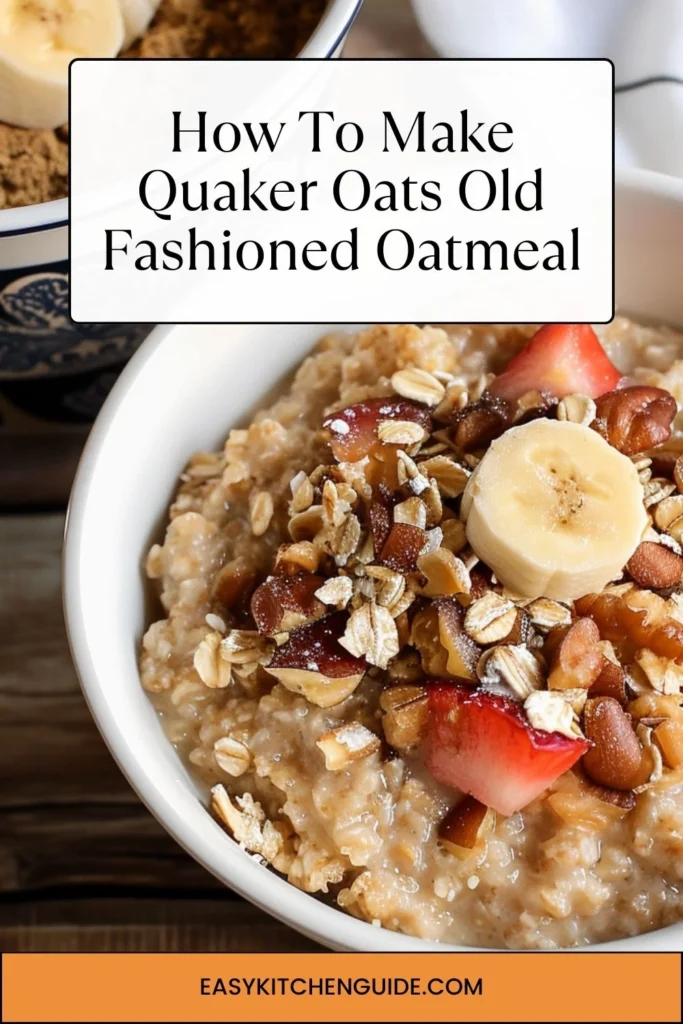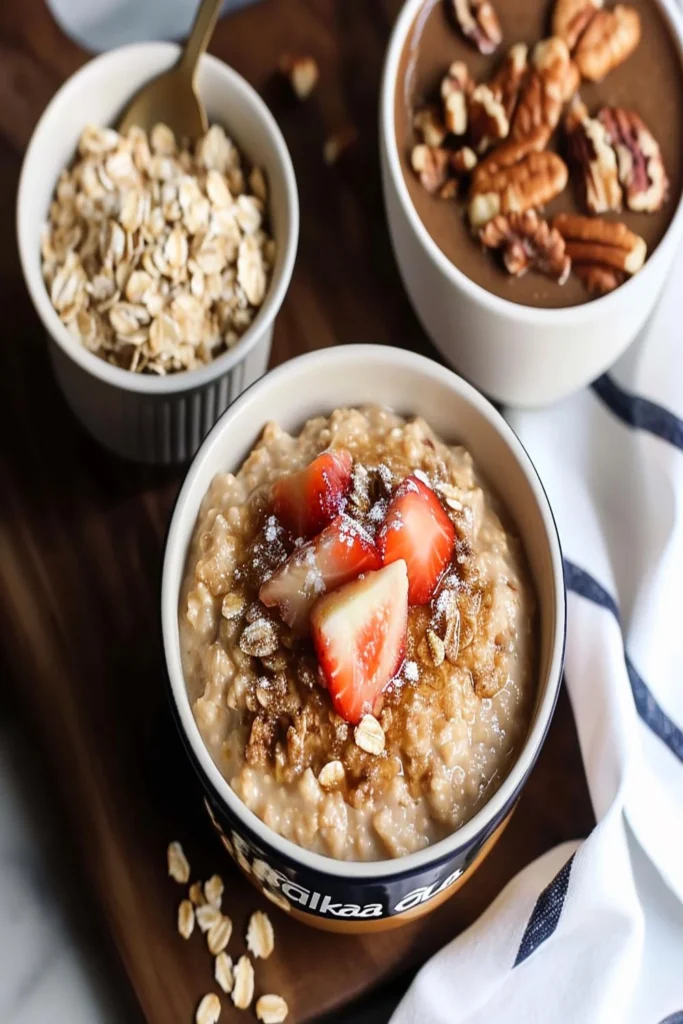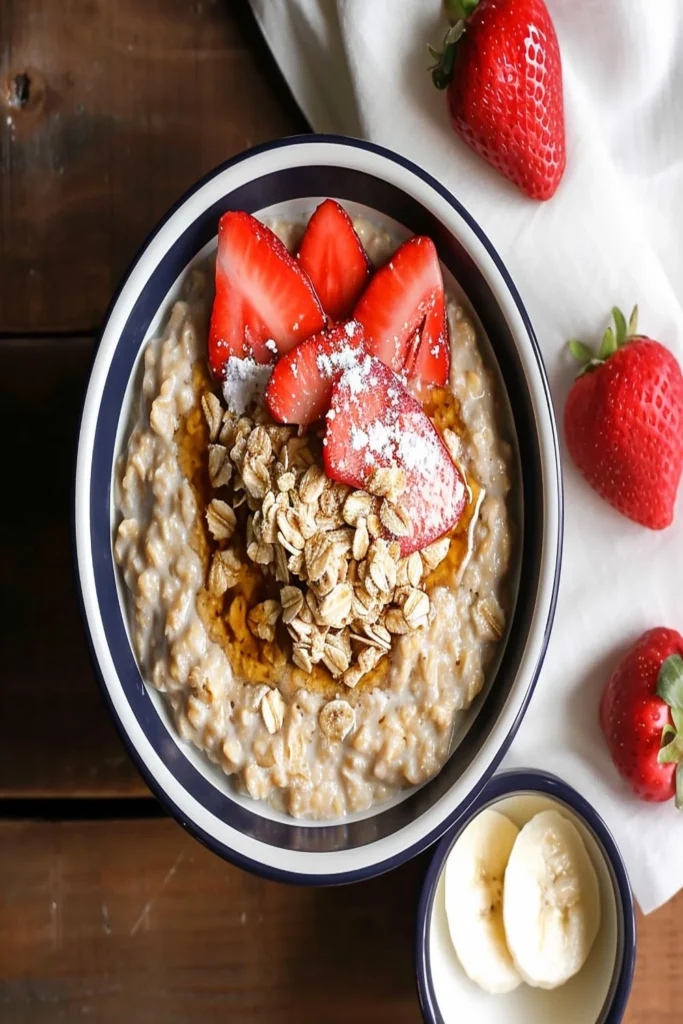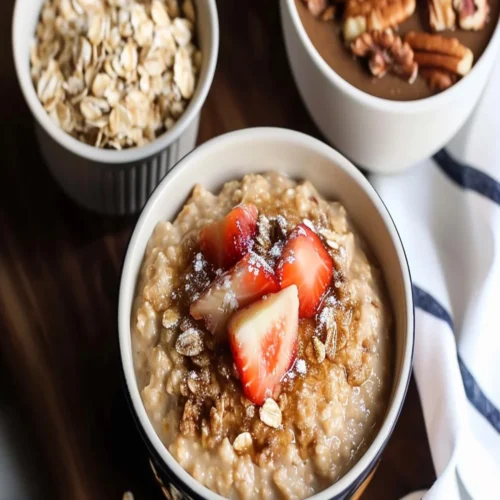Quaker Oats has been a staple in American pantries for more than a century, and its classic old fashioned oatmeal is a favorite breakfast option. Whether you’re cooking up a single serving or batch cooking overnight oats, this breakfast favorite is a simple and easy way to start the day.
In this article, we’ll discuss how to make Quaker Oats Old Fashioned Oatmeal, the ingredients you’ll need, and some storage and serving tips.

What is how to make Quaker Oats Old Fashioned Oatmeal?
The American food business Quaker, also known as the Quaker Oats Company, is headquartered in Chicago, Illinois. The business was established in Ravenna, Ohio, in 1877 under the name Quaker Mill Company. Henry Crowell acquired the business in 1881 and began a nationwide Quaker Oats advertising campaign.
The Quaker Oats Old Fashioned Oatmeal is a classic oatmeal made with oats, water, and a pinch of salt. It’s a simple, yet versatile breakfast option that can be enjoyed on its own or used in a variety of recipes.
With its nutty flavor and hearty texture, it’s no wonder why Quaker Oats Old Fashioned Oatmeal has been a staple in American pantries for decades.
Why You’ll Love this how to make Quaker Oats Old Fashioned Oatmeal?
Quaker Oats Old Fashioned Oatmeal is a quick and easy breakfast option that is packed with a variety of health benefits. Oats are high in soluble fiber and protein, making it a great choice for those looking to maintain a healthy diet.
Additionally, oats are rich in a variety of vitamins and minerals, including magnesium, phosphorus, thiamin, and iron. These vitamins and minerals help support the immune system, reduce inflammation, and promote healthy digestion.
You’ll also like the following Dinner recipes!
- Lion House Banana Bread Copycat Recipe
- How to Make Creme Fraiche Scrambled Eggs
- Publix Breakfast Bread
The Ingredients
- Organic Rolled Oats: These oats are the main ingredient, providing a hearty and nutritious base for the oatmeal. They’re rich in fiber and help create a creamy texture when cooked.
- Almond Milk or Organic Dairy Milk: Used as the liquid for cooking the oats, these milks add creaminess and richness to the oatmeal. Almond milk provides a nutty flavor, while dairy milk offers a classic taste.
- Himalayan Pink Salt (Optional; Omit for Low Sodium Diets): Salt enhances the overall flavor of the oatmeal, bringing out its natural taste. It’s optional and can be omitted for those following low-sodium diets, as the oatmeal can still be flavorful without it.

Directions
Step 1. Combine Oats and Liquid:
- Get a medium-sized saucepan and pour in 2 cups of organic rolled oats.
- Add 3 ½ cups of almond milk or organic dairy milk into the saucepan containing the oats.
Step 2. Optional: Add Salt (if desired):
If preferred, sprinkle 1/4 teaspoon of Himalayan pink salt into the oatmeal mixture. Note: This step is entirely optional and can be skipped for individuals following low-sodium diets.
Step 3. Stir and Heat:
- Place the saucepan over medium heat on the stove.
- Using a wooden spoon or spatula, continuously stir the oatmeal mixture to thoroughly combine all the ingredients.
Step 4. Bring to a Boil:
Allow the oatmeal mixture to reach a gentle boil, making sure to stir occasionally. This boiling process typically takes around 5-7 minutes.
Step 5. Simmer and Cook:
- Once the mixture starts boiling, reduce the heat to low or medium-low to maintain a gentle simmer.
- Continue cooking the oatmeal for an additional 5-10 minutes, stirring occasionally. The oatmeal will gradually thicken as it cooks.
Step 6. Check Consistency:
As the oatmeal cooks, monitor its consistency. For a thicker oatmeal, cook it a bit longer. If a thinner consistency is preferred, consider adding more milk to achieve the desired texture.
Step 7. Remove From Heat and Rest:
Once the oatmeal reaches the desired thickness and consistency, remove the saucepan from the heat source.
Step 8. Let it Rest:
Allow the oatmeal to sit in the saucepan for a minute or two. This short resting period helps the oatmeal to further thicken and settle.
Step 9. Serve:
After the resting period, using a ladle or spoon, scoop the prepared oatmeal into serving bowls or dishes.
Step 10. Add Toppings (if desired):
Customize your oatmeal by adding various toppings like fresh fruits, nuts, seeds, honey, maple syrup, or any other preferred toppings to enhance both the flavor and texture.
Step 11. Enjoy:
Serve the warm and comforting Quaker Oats Old Fashioned Oatmeal immediately. Delight in this delicious and nutritious breakfast that’s ready to be savored!
Notes
Here are a few tips for making the perfect bowl of Quaker Oats Old Fashioned Oatmeal:
• Use cold water when making the oatmeal to avoid a gummy texture.
• For a richer flavor, use a combination of water and milk.
• Add a pinch of salt to enhance the flavor of the oatmeal.
• Stir the oatmeal occasionally while cooking to prevent it from sticking to the bottom of the pan.
• Let the oatmeal sit for a few minutes after cooking to allow it to thicken.
• Feel free to add a sweetener of your choice, such as honey or maple syrup.
• For a creamier texture, add a dollop of butter or cream.
Storage Tips
Leftover oatmeal can be stored in an airtight container in the refrigerator for up to 5 days. To reheat, simply add a few tablespoons of water or milk to the oatmeal and microwave for 1-2 minutes.

Nutrition Information
A single serving of Quaker Oats Old Fashioned Oatmeal contains 154 calories, 3.5g of fat, 24g of carbohydrates, 4g of fiber, and 5g of protein.
Serving Suggestions
Quaker Oats Old Fashioned Oatmeal can be enjoyed as is or topped with a variety of toppings. Here are some tasty topping ideas:
• Fresh or dried fruit
• Nuts and seeds
• Nut butter
• Coconut flakes
• Honey or maple syrup
• Cinnamon
• Vanilla extract
• Chocolate chips
What other substitute can I use in how to make Quaker Oats Old Fashioned Oatmeal?
If you don’t have Quaker Oats on hand, you can use any type of rolled oats in this recipe. Rolled oats are oats that have been steamed and rolled into flakes, making them easier to cook and digest. Other types of rolled oats include quick-cooking rolled oats, steel-cut oats, and Scottish oats.

How To Make Quaker Oats Old Fashioned Oatmeal
Equipment
- Medium-sized saucepan
- wooden spoon or spatula
Ingredients
- 3 ½ cups almond milk or organic dairy milk
- 1/4 Tsp. Himalayan pink salt optional; omit for low sodium diets
- 2 cups organic rolled oats
Instructions
Combine Oats and Liquid:
- In a medium-sized saucepan, pour in the 2 cups of organic rolled oats.
- Add the 3 ½ cups of almond milk or organic dairy milk to the saucepan with the oats.
Optional: Add Salt (if desired):
- If using salt, sprinkle 1/4 teaspoon of Himalayan pink salt into the mixture. This step is optional and can be omitted for those on low-sodium diets.
Stir and Heat:
- Place the saucepan over medium heat on the stove.
- Stir the oatmeal mixture continuously using a wooden spoon or spatula to combine the ingredients thoroughly.
Bring to a Boil:
- Allow the oatmeal mixture to come to a gentle boil while stirring occasionally. This may take approximately 5-7 minutes.
Simmer and Cook:
- Once the mixture reaches a gentle boil, reduce the heat to low or medium-low to maintain a simmer.
- Continue to cook the oatmeal for about 5-10 more minutes, stirring occasionally. The oatmeal will thicken as it cooks.
Check Consistency:
- Monitor the oatmeal’s consistency as it cooks. If you prefer a thicker consistency, cook it for a bit longer. For a thinner consistency, add more milk if desired.
Remove From Heat and Rest:
- Once the oatmeal reaches your desired thickness and consistency, remove the saucepan from the heat.
Let it Rest:
- Allow the oatmeal to sit in the saucepan for a minute or two. This resting period helps the oatmeal to further thicken and settle.
Serve:
- After resting, scoop the prepared oatmeal into serving bowls or dishes.
Add Toppings (if desired):
- Customize your oatmeal by adding toppings such as fresh fruits, nuts, seeds, honey, maple syrup, or any other preferred toppings for added flavor and texture.
Enjoy:
- Serve the warm and comforting Quaker Oats Old Fashioned Oatmeal immediately and enjoy a delicious and nutritious breakfast!
Notes
- Use cold water when making the oatmeal to avoid a gummy texture.
- For a richer flavor, use a combination of water and milk.
- Add a pinch of salt to enhance the flavor of the oatmeal.
- Stir the oatmeal occasionally while cooking to prevent it from sticking to the bottom of the pan.
- Let the oatmeal sit for a few minutes after cooking to allow it to thicken.
- Feel free to add a sweetener of your choice, such as honey or maple syrup.
- For a creamier texture, add a dollop of butter or cream.
Frequently Asked Questions
Q1. Can I use quick-cooking oats for this recipe?
A1. No, quick-cooking oats will not work for this recipe. Quick-cooking oats are pre-cooked and designed to cook quickly, so they will not hold up to the same amount of cooking time as regular oats.
Q2. Can I use milk instead of water?
A2. Yes, you can use a combination of water and milk for a richer flavor.
Q3. How long will the oatmeal last in the refrigerator?
A3. Leftover oatmeal can be stored in the refrigerator for up to 5 days.
Q4. Can I freeze oatmeal?
A4. Yes, oatmeal can be frozen in an airtight container for up to 3 months.
Q5. Can I add sweetener to the oatmeal?
A5. Yes, you can add a sweetener of your choice, such as honey or maple syrup.
Q6. Is oatmeal good for you?
A6. Yes, oatmeal is a great source of fiber and protein and is rich in a variety of vitamins and minerals.
Q7. Is Quaker Oats Old Fashioned Oatmeal gluten-free?
A7. Yes, Quaker Oats Old Fashioned Oatmeal is gluten-free.
Conclusion
Quaker Oats Old Fashioned Oatmeal is a classic breakfast favorite that is simple to make and packed with a variety of health benefits. With just a few ingredients and a few minutes of time, you can enjoy a hearty and delicious bowl of oatmeal.
Whether you’re enjoying it on its own or topping it with your favorite mix-ins, Quaker Oats Old Fashioned Oatmeal is sure to become a staple in your breakfast routine.
You’ll also like the latest recipes!
My name is Lori Walker. I’m a registered dietitian, food blogger and food enthusiast. I share easy healthy, delicious recipes on my blog and review necessary kitchen items. The recipes I share take less… Read more
